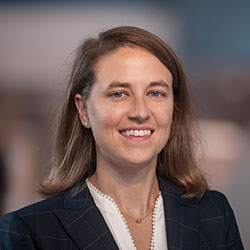Scoliosis and Back Pain: A Q&A With Dr. Jennifer Bauer
January 8, 2020
 Jennifer Bauer, MD, MS is the only orthopaedic surgeon at Seattle Children’s whose elective practice is singularly dedicated to the treatment of pediatric spine problems.
Jennifer Bauer, MD, MS is the only orthopaedic surgeon at Seattle Children’s whose elective practice is singularly dedicated to the treatment of pediatric spine problems.
She has been selected this year for both the Scoliosis Research Society’s Edgar Dawson North American Traveling Fellowship and the Pediatric Orthopaedic Society of North America’s International Traveling Fellowship, both of which will bring her to other leading centers to exchange ideas, give lectures and discuss research collaboration.
What is the basic treatment algorithm for idiopathic scoliosis?
Dr. Bauer: In general, children with curves of 20 to 25 degrees on an upright spine radiograph who still have at least a moderate amount of growth remaining (Risser 0-2) will be recommended a thoracolumbosacral orthosis (TLSO) brace to keep the curve from progressing, as well as offered scoliosis-specific Schroth physical therapy as an adjunct to the brace. This is continued until growth stops. If a child is younger than 5, they may be casted instead of braced. Children with curves over 45 to 50 degrees who still have a large amount of growth left will be offered surgery with growth-friendly implants that allow continued height. These will be converted to a final fusion once appropriate growth has completed. In patients with curves of this size without as much growth left (at least after their tri-radiate cartilages have closed), a final fusion may be recommended. The goal for surgery is to stop a curve from progressing, as curves that reach 70 to 80 degrees affect pulmonary function, and secondarily to correct deformity. The majority of curves over 50 degrees, even after a child stops growing, will continue to slowly progress, and thus these are offered surgery.
Can a child outgrow their scoliosis?
Dr. Bauer: Rarely, a sudden scoliotic appearance can be caused by a source of pain, tumor, or spinal cord abnormality. In these cases, treating the offending cause can cure the appearance of the curve. Also, an infant with a flexible curve may straighten as they develop truncal strength and an upright posture to walk. Otherwise, children do not outgrow their scoliosis. On the contrary, the faster a child grows, the bigger their curve gets. Being able to start treatments before big growth spurts is therefore critical.
What is unique about scoliosis care at Seattle Children’s?
Dr. Bauer: Seattle Children’s specializes in all spine pathologies, from the complex to the most common. Because we see such a large volume, we have developed entire pediatric-spine-specific teams, from our surgeons to nurses in the OR, to the anesthesia providers, physical therapists, and nurses on the floor. Research has shown that these specialty teams deliver better care, and here, too, we have seen the protocols that this team developed decrease the amount of narcotic pain medicine needed after surgery by over 50%, and the length of stay by a full day. Our surgeons are academic leaders in the field, presenting internationally on their spine research and collaborating with a rich network of other leaders to offer the best possible treatment options for their patients. This type of exchange has helped us value important advancements, like our low-dose EOS X-ray machine to decrease radiation to our patients, and the Schroth physical therapy our team offers at the hospital and Bellevue Clinic, while pushing to develop more.
What findings should make me concerned about pediatric back pain?
Dr. Bauer: Back pain is common in teens and pre-teens, and can be associated with deconditioning from sedentary lifestyle, overuse, or particularly exacerbated by stress, anxiety or depression. These are important sources to address when treating the pain. Scoliosis should not be assumed to cause pain in children, as most even with very large curves have none; however, some with scoliosis, especially paired with one of the problems mentioned, such as deconditioning, report discomfort. Rarely, pain is from something more concerning. Diffuse numbness or tingling can be reported with back pain, but true radicular/dermatomal numbness that persists, positive straight-leg raise or positive femoral nerve tension test should raise concern. Pain that wakes a child up at night or is associated with weight loss or other constitutional symptoms or any weakness, altered coordination or bladder/bowel function should be further investigated. Lumbar spondylolysis is one of the most common causes referred to us, and is almost universally treated non-operatively.